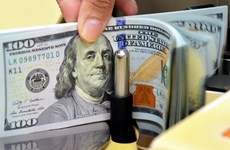Trade deficit of 6.6 bln USD forecast for first half
Vietnam's export value in June is estimated to hit 7.8 billion USD,
lifting the total export value in the first half of this year to more
than 42.33 billion USD, a rise of 30.3 percent over the same period a
year earlier, according to the General Statistics Office (GSO).
The import value in June is forecast to reach 8.2 billion USD, bringing the total value for the first six months to almost 49 billion USD, a year-on-year increase of 25.8 percent.
The import value in June is forecast to reach 8.2 billion USD, bringing the total value for the first six months to almost 49 billion USD, a year-on-year increase of 25.8 percent.
Vietnam's export value in June is estimated to hit 7.8 billion USD,
lifting the total export value in the first half of this year to more
than 42.33 billion USD, a rise of 30.3 percent over the same period a
year earlier, according to the General Statistics Office (GSO).
The import value in June is forecast to reach 8.2 billion USD, bringing the total value for the first six months to almost 49 billion USD, a year-on-year increase of 25.8 percent.
According to these figures, the trade deficit for the first half of the year is estimated to reach over 6.65 billion USD – the highest it has been since the beginning of this year. The trade deficit was just 1 billion USD in January, 1.83 billion USD for the first two months, 3.03 billion USD for the first three months, 4.9 billion USD for the first four months and nearly 6.59 billion USD for the first five months.
The January-June trade gap accounts for 15.7 percent of the export value during the period lower than the Government's target of 16 percent set for the whole year. However, according to the GSO, the trade deficit actually made up 18.1 percent if the value of gold exports was excluded during that period.
Le Minh Thuy, head of the GSO's Trade Department, blamed the high trade deficit in the first half on the high import demand of domestic enterprises which was worth nearly 27.58 billion USD, a rise of 22.9 percent year-on-year, and higher than the import value of foreign-invested enterprises which was worth 21.41 billion USD, a rise of 29.7 percent year-on-year.
The import value of machinery-equipment-devices, and accessories and spare parts was the highest, reaching over 6.93 billion USD, a rise of nearly 11 percent year-on-year. Due to the increased global prices, the value of fuel imports reached 5.49 billion USD, a rise of 40.3 percent year-on-year, despite the volume being down 2.1 percent.
The import value of many of raw materials used for domestic production also rose due to increased global prices, including plastics up 31.5 percent; fabric, 38.1 percent; steel, 7 percent; electronics, computers and spare parts, 23.2 percent and cotton, 103.6 percent.
Agricultural imports also climbed, with the import value of wheat reaching 467 million USD, a rise of 58.5 percent; cooking oil 404 million USD, up 39.1 percent; vegetables 407 million USD, up 14 percent and seafood 206 million USD, up 35.5 per .
Automobile imports reached almost 1.55 billion USD, a rise of 16 percent, of which imports of CBU (complete built unit) reached 31,600 units worth 593 million USD, an increase of 37.1 percent in volume and 45.9 percent in value.
Thuy said the trade deficit was cushioned by rising export value of 30.3 percent, tripling the Government's target of 10 percent for this year, of which the export value of domestic enterprises reached 19.38 billion USD, a rise of 29.4 percent, and foreign-invested enterprises reached over 22.95 billion USD, a rise of 31.1 percent.
The export of agriculture and fishery products rose significantly due to the increased global prices, including seafood rising 28 percent to nearly 2.59 billion USD; rice up 16 percent to 1.97 billion USD; coffee up 103 percent to 1.93 billion USD and cassava up 40.4 percent to 580 million USD.
Crude oil exports earned over 3.38 billion USD on a volume of over 3.94 million tonnes during the period, a rise of 26.2 percent in value but a decrease of 10.5 in volume.
Garments and textiles earned a total export value of 6.11 billion USD, a rise of 28.4 percent, and footwear exports made nearly 2.99 billion USD, up 31 percent.
According to economists, promoting exports of high value-added goods and less dependence on imports of raw materials will be the most effective way to reduce the trade deficit. However, Vietnam's efforts to reduce trade imbalance in the coming time are likely to meet with difficulties due to persisting high import demand for raw materials and rising prices on the global market./.
The import value in June is forecast to reach 8.2 billion USD, bringing the total value for the first six months to almost 49 billion USD, a year-on-year increase of 25.8 percent.
According to these figures, the trade deficit for the first half of the year is estimated to reach over 6.65 billion USD – the highest it has been since the beginning of this year. The trade deficit was just 1 billion USD in January, 1.83 billion USD for the first two months, 3.03 billion USD for the first three months, 4.9 billion USD for the first four months and nearly 6.59 billion USD for the first five months.
The January-June trade gap accounts for 15.7 percent of the export value during the period lower than the Government's target of 16 percent set for the whole year. However, according to the GSO, the trade deficit actually made up 18.1 percent if the value of gold exports was excluded during that period.
Le Minh Thuy, head of the GSO's Trade Department, blamed the high trade deficit in the first half on the high import demand of domestic enterprises which was worth nearly 27.58 billion USD, a rise of 22.9 percent year-on-year, and higher than the import value of foreign-invested enterprises which was worth 21.41 billion USD, a rise of 29.7 percent year-on-year.
The import value of machinery-equipment-devices, and accessories and spare parts was the highest, reaching over 6.93 billion USD, a rise of nearly 11 percent year-on-year. Due to the increased global prices, the value of fuel imports reached 5.49 billion USD, a rise of 40.3 percent year-on-year, despite the volume being down 2.1 percent.
The import value of many of raw materials used for domestic production also rose due to increased global prices, including plastics up 31.5 percent; fabric, 38.1 percent; steel, 7 percent; electronics, computers and spare parts, 23.2 percent and cotton, 103.6 percent.
Agricultural imports also climbed, with the import value of wheat reaching 467 million USD, a rise of 58.5 percent; cooking oil 404 million USD, up 39.1 percent; vegetables 407 million USD, up 14 percent and seafood 206 million USD, up 35.5 per .
Automobile imports reached almost 1.55 billion USD, a rise of 16 percent, of which imports of CBU (complete built unit) reached 31,600 units worth 593 million USD, an increase of 37.1 percent in volume and 45.9 percent in value.
Thuy said the trade deficit was cushioned by rising export value of 30.3 percent, tripling the Government's target of 10 percent for this year, of which the export value of domestic enterprises reached 19.38 billion USD, a rise of 29.4 percent, and foreign-invested enterprises reached over 22.95 billion USD, a rise of 31.1 percent.
The export of agriculture and fishery products rose significantly due to the increased global prices, including seafood rising 28 percent to nearly 2.59 billion USD; rice up 16 percent to 1.97 billion USD; coffee up 103 percent to 1.93 billion USD and cassava up 40.4 percent to 580 million USD.
Crude oil exports earned over 3.38 billion USD on a volume of over 3.94 million tonnes during the period, a rise of 26.2 percent in value but a decrease of 10.5 in volume.
Garments and textiles earned a total export value of 6.11 billion USD, a rise of 28.4 percent, and footwear exports made nearly 2.99 billion USD, up 31 percent.
According to economists, promoting exports of high value-added goods and less dependence on imports of raw materials will be the most effective way to reduce the trade deficit. However, Vietnam's efforts to reduce trade imbalance in the coming time are likely to meet with difficulties due to persisting high import demand for raw materials and rising prices on the global market./.













